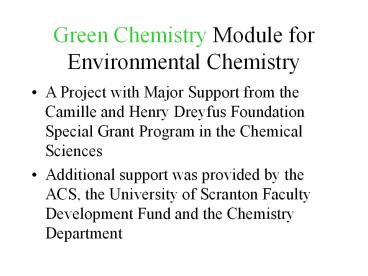Green Chemistry Module for Environmental Chemistry - PowerPoint PPT Presentation
Title:
Green Chemistry Module for Environmental Chemistry
Description:
Green Chemistry Module for Environmental Chemistry A Project with Major Support from the Camille and Henry Dreyfus Foundation Special Grant Program in the Chemical ... – PowerPoint PPT presentation
Number of Views:174
Avg rating:3.0/5.0
Title: Green Chemistry Module for Environmental Chemistry
1
Green Chemistry Module for Environmental Chemistry
- A Project with Major Support from the Camille and
Henry Dreyfus Foundation Special Grant Program in
the Chemical Sciences - Additional support was provided by the ACS, the
University of Scranton Faculty Development Fund
and the Chemistry Department
2
Topic Sea-nine Antifoulant
- A Marine Pesticide
3
Chemical Pesticides
- Insecticides
- Herbicides
- Disinfectants
- Rodenticides
- Algicides
- Molluscicides
- Pisicides
- Fungicides
- Avicides
4
Foulants
- Soft Foulants (algae and seweed)
- Hard Foulants (barnacles and diatoms)
5
Costs of Fouling
- Increased fuel consumption, 3 billion/year
- Increased time in Dry-dock, 2.7 billion/year
- To clean ship
- For being out of service
6
Environmental Costs of Fouling
- Increased consumption of fossil fuels (a
nonrenewable resource) - Increased formation of carbon dioxide (a
greenhouse gas) - Increased formation of other atmospheric
pollutants (nitrogen oxides, sulfur oxides,
unburned hydrocarbons, ozone etc.)
7
Antifoulants
- Used to control the growth of marine organisms
(algae and seaweed-soft foulants barnacles and
diatoms-hard foulants) - Usually mixed with the paint as it is applied to
the hull - Slowly leach form the surface of the hull
8
Organotin Antifoulants
- Tributyltin Oxide TBTO
9
Environmental Concerns of TBTO
- Half-life of TBTO in seawater is gt 6 months
- Bioconcentration, 104
- Chronic Toxicity
- Thickness of oyster shells
- Sex changes in whelks
- Imposex in snails
- Immune system in dolphins and others?
10
Ban on Organotin Antifoulants
- US -Organotin Antifouling Paint Control Act of
1998 (OAPCA) - Ban by Japan
- International Maritime Organization (IMO)
complete ban on 1/1/03
11
Environmentally Preferable Antifoulants
- Ideal Properties
- Rapid degradation
- Nonhazardous environmental concentrations
- Limited bioavailability
- Toxic only to target organisms
- Minimum Bioconcentration
12
Sea-Nine 211 Antifoulant
- Rohm and Haas
- Presidential Green Chemistry Challenge Award
- Active ingredient
- 4,5-dichloro-2-n-octyl-4-isothiazolin-3-one
- (DCOI)
- Mode of action
13
Environmental Risk
- ER f(toxicity and exposure)
- DCOI limits ER by limiting exposure
14
Properties of DCOI
- Acutely toxic to a wide range of marine organisms
(effective anitfoulant) - Rapid biodegradation to nontoxic products
- (½ life lt 1hour)
- Low Bioconcnetration
- (bioconcentration 13)
- Environmental Conc. lt Acute Toxicity level
- No Chronic Toxicity
- Rapid partitioning to the sediment
- (low bioavailability)
15
Biodegradation of DCOI
16
Risk Quotient
- RQ PEC/PNEC
- DCOI RQ 0.024-0.36
- TBTO RQ 15-430
- PEC (predicted environmental concentration)
- PNEC (predicted no-effect environmental
concentration)































